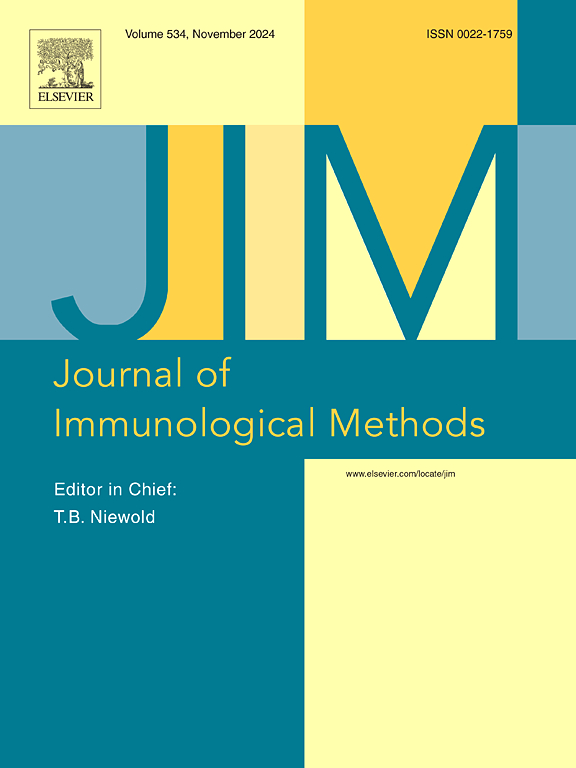Chlamydia trachomatis pgp3 ELISA
IF 1.6
4区 医学
Q4 BIOCHEMICAL RESEARCH METHODS
引用次数: 0
Abstract
Chlamydia trachomatis (Ct) serology is an important tool to support infection and disease surveillance of the population but there are currently no formal reference reagents and few commercial assays available. Our objective was to develop an internally standardized ELISA capable of estimating antibody levels against the virulence factor antigen, pgp3, that could be used for Ct serosurveillance. Purified trimeric pgp3 antigen was stable and the internal standard, quality controls, intra- and inter-assay repeatability metrics were robust. For example, retesting a panel of serum samples (n = 203) resulted in 12 % and 13 % seropositivity for the initial and repeat tests, respectively (Kappa 0.933, 95 %CI 0.857–1.000). A comparison of serum samples from children who would not be expected to have had exposure to Ct and samples from females with a history of chlamydia infection, though not necessarily antibody positive at the time of sampling, generated excellent specificity (99.4 %) and adequate sensitivity (67.9 %) for surveillance purposes. The pgp3 ELISA reports results in antibody levels (AU/mL) which are amenable to recalibration should an international reference reagent be approved in the future.
沙眼衣原体pgp3 ELISA试剂盒
沙眼衣原体(Ct)血清学是支持人群感染和疾病监测的重要工具,但目前没有正式的参考试剂,商业检测方法也很少。我们的目标是开发一种内部标准化的ELISA,能够估计针对毒力因子抗原pgp3的抗体水平,可用于Ct血清监测。纯化的三聚体pgp3抗原是稳定的,内标、质量控制、内和间重复性指标是稳健的。例如,重新检测一组血清样本(n = 203),首次检测和重复检测的血清阳性率分别为12%和13% (Kappa 0.933, 95% CI 0.857-1.000)。对没有接触过Ct的儿童的血清样本和有衣原体感染史的女性的血清样本进行比较,虽然取样时不一定抗体呈阳性,但产生了极好的特异性(99.4%)和足够的灵敏度(67.9%),用于监测目的。pgp3 ELISA报告抗体水平(AU/mL),如果将来有国际标准试剂批准,可以重新校准。
本文章由计算机程序翻译,如有差异,请以英文原文为准。
求助全文
约1分钟内获得全文
求助全文
来源期刊
CiteScore
4.10
自引率
0.00%
发文量
120
审稿时长
3 months
期刊介绍:
The Journal of Immunological Methods is devoted to covering techniques for: (1) Quantitating and detecting antibodies and/or antigens. (2) Purifying immunoglobulins, lymphokines and other molecules of the immune system. (3) Isolating antigens and other substances important in immunological processes. (4) Labelling antigens and antibodies. (5) Localizing antigens and/or antibodies in tissues and cells. (6) Detecting, and fractionating immunocompetent cells. (7) Assaying for cellular immunity. (8) Documenting cell-cell interactions. (9) Initiating immunity and unresponsiveness. (10) Transplanting tissues. (11) Studying items closely related to immunity such as complement, reticuloendothelial system and others. (12) Molecular techniques for studying immune cells and their receptors. (13) Imaging of the immune system. (14) Methods for production or their fragments in eukaryotic and prokaryotic cells.
In addition the journal will publish articles on novel methods for analysing the organization, structure and expression of genes for immunologically important molecules such as immunoglobulins, T cell receptors and accessory molecules involved in antigen recognition, processing and presentation. Submitted full length manuscripts should describe new methods of broad applicability to immunology and not simply the application of an established method to a particular substance - although papers describing such applications may be considered for publication as a short Technical Note. Review articles will also be published by the Journal of Immunological Methods. In general these manuscripts are by solicitation however anyone interested in submitting a review can contact the Reviews Editor and provide an outline of the proposed review.

 求助内容:
求助内容: 应助结果提醒方式:
应助结果提醒方式:


